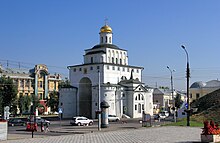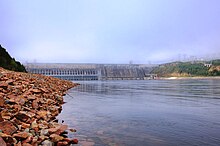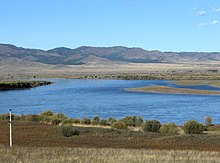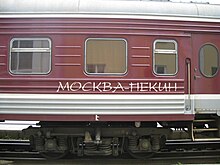- This article is a Travel route.


The Trans-Siberian Railway (Транссибирская магистраль or Транссиб in Russian), is a railway axis that connects Moscow and the European Russia with its Russian provinces Far East, τη Mongolia, the China and its Sea Japan. The main route, the Trans-Siberian, arrives from Moscow in the Vladivostok through the south Siberian and was built between 1891 and 1916. With 9,288 kilometers, in 8 time zones, the journey takes about 7 days. Today, four other routes start from the Trans-Siberian.

Generally

History
By the end of the 19th century Russia was already a world superpower, but movement and trade were almost entirely in its western provinces and in large cities such as Moscow and St. Petersburg. The eastern - Asian - Siberian part of the country was cut off. In 1891, the Russian government decided to build a railway line that would connect Moscow with the port of Vladivostok, thousands of miles off the east coast of Russia, in Siberia, in the Sea of Japan. The construction of the Trans-Siberian was completed 25 years later (1916), while from 1908, next to the original single line, a second one was built. At the same time, simple stations of the Trans-Siberian Railway gradually evolved into urban industrial centers.

Preparation

How to get there

Visa issuance information
Tickets

Numbering of stations
Station numbering is used internally in the railway information system, but is often printed on tickets as well. Their knowledge can be useful when booking tickets at small train stations, or when buying a ticket from abroad.
At the ticket counter
|
International stations
The stations are listed in order from west to east
- 5100136 Warsaw/Poland - Central station (Warsaw Central)
- 2100035 Brest/Belarus (Brest)
- 1000001 Helsinki/Finland (Helsinki)
- 3100022 Ulan Bator/Mongolia (Ulan-Bator)
- 3300100 Beijing/China (Beijing, 北京)
- 3300200 Harbin/China (Harbin, 哈尔滨)
Russian stations
The stations are listed in order from west to east
- 2058000 Kaliningrad (Kaliningrad)
- 2004000 Saint Petersburg (St. Petersburg)
- 2004001 Saint Petersburg - Glavnyi Station (St. Petersburg (Main Vocal))
- 2004004 Saint Petersburg - Finliandskii Station (St. Petersburg (Finnish Vowel))
- 2000000 Moscow (Moscow)
- 2000002 Moscow - Yaroslavskij Station (Moscow (Ярославский Вокзал))
- 2000003 Moscow - Kazanskij Station (Moscow (Kazan Vokzal))
- 2000006 Moscow - Bieloruskij Station (Moscow (Belarusian Vokzal))
- 2060001 Nizhny Novgorod (Nizhny Novgorod) - often referred to as Gorki (Горький)
- 2060500 Kazan (Казань)
- 2030000 Yekaterinburg (Yekaterinburg) - often referred to as Sverdlovsk (Sverdlovsk)
- 2044001 Novosibirsk (Novosibirsk)
- 2028170 Tomsk (Tomsk)
- 2038001 Krasnoyarsk (Krasnoyarsk)
- 2054052 Severobaikalsk (Северобайкальск)
- 2054001 Irkutsk (Irkutsk)
- 2054785 Ulan Ude (Улан-Удэ)
- 2034001 Khabarovsk (Khabarovsk)
- 2034130 Vladivostok (Vladivostok)
Prices
Areas
Trans-Siberian









| City | Km distance from Moscow | Duration from Moscow | Time zone | Description |
|---|---|---|---|---|
| Moscow (Moscow) | 0 km | 0 hours | Moscow | The Russian capital has some world-famous attractions, such as the Kremlin, Red Square and St. Basil's Church. Moscow is a perfect destination for anyone interested in Russian history, museums, old churches and buildings from the Soviet period and beyond. |
| Vladimir (Vladimir) | 210 km | 3h | Moscow | Founded in the 12th century, Vladimir is known for its medieval stone architecture, it is UNESCO World Heritage Site and part of it Gold Ring. If you travel by slow train, you will cross it Yaroslav, the historic center of this city is also UNESCO World Heritage Site and part of it Gold Ring, although it is of a later period. |
| Nizhny Novgorod (Nizhny Novgorod) | 442 km | 6 hours | Moscow | During the Soviet era, this 13th-century city was called Gorky, and among its museums is that of the author. Like Moscow and other Russian cities, Nizhny Novgorod has a Kremlin. In addition, it is located next to the Volga River and has a wide range of Russian traditional architecture. |
| Volga river bridge | 447 km | 6 hours | Moscow | The first major Russian river to cross is the Volga, just after the Nizhny Novgorod railway station. |
| Perm (Perm) | 1,436 km | 20 hours | Moscow 2 | Perm is known for its cultural events and institutions such as PERMM. Nearby extensions include a cave at Kungur and a former Gulag labor camp which has become a museum. |
| Europe-Asia border | 1,777 km | 1 day, 1 hour | Moscow 2 | The border between Europe and Asia is marked by the existence of a white obelisk in the forest. |
| Yekaterinburg (Yekaterinburg) | 1,816 km | 1 day, 1 hour | Moscow 2 | The capital of the Urals has a spectacular range of Soviet buildings and interesting museums on art and nature. |
| Tyumen (Тюме́нь) | 2,144 km | 1 day, 6 hours | Moscow 2 | Tyumen was one of the first Russian fortresses in Siberia. It's a good place to explore Tyumen area, which includes its ancient city Tobolsk, the first Russian settlement in Siberia with old Russian architecture, with wooden houses. |
| Irtysh river crossing | 2,706 km | 1 day, 13 hours | Moscow 3 | Before reaching Omsk, it will cross the Irtysh River. |
| Omsk (Omsk) | 2,712 km | 1 day, 13 hours | Moscow 3 | Omsi was for a short time after the revolution the capital of Belarus. Attractions include a military museum, the Cossack Cathedral and Siberian houses made of carved timber. |
| Ob river crossing | 3,332 km | 1 day, 22 hours | Moscow 3 | The Ob, another large river, is crossed before reaching Novosibirsk. |
| Novosibirsk (Novosibirsk) | 3,335 km | 1 day, 22 hours | Moscow 3 | The third largest city in Russia, and the most interesting stop. Attractions include the historic city center, a zoo, Lenin Square and the adjacent geographical center of the Soviet Union. It is a starting point for trips to the Altai Mountains and Kazakhstan. |
| Tayga (Тайга́) | 3,565 km | 2 days, 1 hour | Moscow 4 | The village of Tayga is not important, but from here it is relatively easy to get to Tomsk, a student city with wooden architecture. |
| Krasnoyarsk (Krasnoyarsk) | 4,095 km | 2 days, 9 hours | Moscow 4 | The picturesque city of Krasnoyarsk was founded by the Cossacks. The city has museums, monuments and shopping malls. Further away there's a huge hydroelectric dam and the Stolby Nature Reserve with granite pillars. If you're going to Beijing via the Trans-Mongolian, you've already come half the distance from Moscow. |
| Yenisey River Crossing | 4,101 km | 2 days, 9 hours | Moscow 4 | And also Krasnoyarsk is situated by a large river, which you will cross on your journey eastwards. |
| BAM junction | 4,515 km | 2 days 15 hours | Moscow 5 | After the village of Tayshet, the Baikal-Amur line goes north. |
| Irkutsk (Irkutsk) | 5,185 km | 3 days, 2 hours | Moscow 5 | Irkutsk is on the banks of one UNESCO World Heritage Site, the Lake Baikal. The city has traditional Siberian wooden houses, an icebreaker, a hydroelectric dam and several churches and museums dedicated to the culture and history of the region. One special souvenir to buy are kamusi - traditional fur boots. From Irkutsk you can also travel with him Circum-Baikal Railway. |
| Ulan Ude (Ulan-Udj) | 5,642 km | 3 days, 11 hours | Moscow 5 | The gate of the Ethnographic Museum shows that you are in the east and not in the west, Ulan Ude has a Mongolian atmosphere, with Buddhist temples and old buildings from the time when it was an important commercial hub in the area. |
| junction with Mongolia line | 5,655 km | 3 days, 11 hours | Moscow 5 | Shortly after Ulan Ude, there is an important railway junction, the central part of the sub-Siberian continues to Vladivostok, while the Mongolian line goes south to Mongolia and China. |
| Chita (Reads) | 6,199 km | 3 days, 18 hours | Moscow 6 | The formerly closed city Chita offers a couple of religious sights. As the city sees few visitors, especially Westerners are seen as a curiosity. |
| junction with Manchuria line | 6,312 km | 4 days, 0 hours | Moscow 6 | Exactly four days after Moscow, the Manchuria line heads south to Beijing. |
| Amur river crossing | 8,515 km | 5 days, 11 hours | Moscow 7 | After a large section without any major cities, it will cross the Amur River, the last major river on the route. The bridge depicts the RUB5,000 banknote. |
| Khabarovsk (Khabarovsk) | 8,521 km | 5 days, 11 hours | Moscow 7 | After the river you reach Khabarovsk. If you are interested in museums, there are many on the subject of Russian from the East. |
| Vladivostok (Vladivostok) | 9,288 km | 6 days, 0 hours | Moscow 7 | After six days, he arrives in Vladivostok in the Pacific Ocean. The railway station is built in the same style as the Yaroslavl station in Moscow, the other end of the Trans-Siberian. The Russian Pacific Fleet is based here, the city was actually built for this purpose, so there are many naval attractions, and scenic nature on the Pacific coast. |
Mongolia Line





Manchuria line





